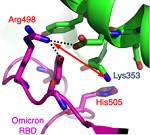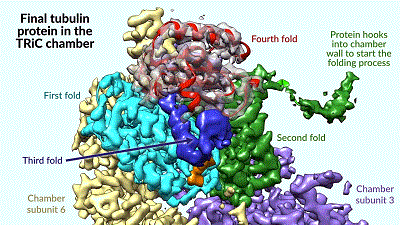
Holiday Message from the Director

As 2022 draws to a close, we want to express our thanks for your contributions to forefront science and technological development. Your support is appreciated as we move forward with the mission of our laboratory while continuing to keep safety as a priority. We are glad to see activities getting back to a new normal with increasing numbers of users onsite for their experiments. We hope to be able to have more onsite events next year including a celebration of SSRL’s 50th year milestone being planned for April 20th, and the joint SSRL/LCLS Users’ Conference being planned for September 2023.
We wish you the very best during this holiday season. We hope the coming year will bring exciting new opportunities.
– Paul McIntyre
SSRL Science Highlight

Structural Evidence that Rodents Facilitated the Evolution of the SARS-CoV-2 Omicron Variant – Contact: Fang Li (University of Minnesota)
The pandemic caused by the COVID-19 virus has been complicated by many viral variants. These variants arise from mutations in the virus that bestow new abilities, such as higher infection rates, greater immune system evasion, or increased viral shedding. The omicron variant of the virus suddenly showed up with multiple mutations in its spike protein. This was an unusual feature, since mutations are usually acquired more gradually. Perhaps the group of spike protein mutations in omicron did occur sequentially but in a population we were not monitoring. A team of researchers from the University of Minnesota have found evidence that the omicron variant of COVID-19 was transferred to humans from an animal host using information about protein structure. Read more...
Science at the Stanford-SLAC CryoEM Facility
Researchers Discover how a Nano-chamber in the Cell Directs Protein Folding
Excerpt from SLAC News Article by Glennda Chui

A landmark study led by Stanford Professor Judith Frydman and SLAC/Stanford Professor Wah Chiu reveals how a tiny cellular machine called TRiC directs the folding of tubulin, a human protein that is the building block of microtubules that serve as the cell’s scaffolding and transport system.
Until now, scientists thought TRiC and similar machines, known as chaperonins, passively provide an environment conducive to folding, but don’t directly participate in it.
“When I met Judith 20 years ago,” Chiu said, “we talked about whether we could see proteins folding. That’s something people have been trying to do for years, and now we have done it.”
The researchers captured four distinct steps in the TRiC-directed folding process at near-atomic resolution with cryoEM, and confirmed what they saw with biochemical and biophysical analyses. Read more...
The cryoEM data for the final results of this decade-long study were collected at the Stanford-SLAC CryoEM Facility which was established at SLAC five years ago with the support of Stanford University, SLAC National Accelerator Laboratory, the National Institutes of Health and the Department of Energy.
Beamline Update
Beamline 17-2, the new in-vacuum undulator facility for materials energy science is now operational and part of the SSRL general user program, while we continue scientific implementation of additional capabilities. Current commissioned experimental capabilities include x-ray diffraction based on a 6-circle diffractometer, as well as an x,y,z, theta, chi diffractometer sample positioning system on the back table of the hutch to support experiments for non-standard sample environments. Non-standard user experiments have thus far included fast operando electrochemical cycling of battery materials, strain-mediated switching of ferroelectric devices, flash annealing of back-end-of-line microelectronic materials, and in-situ monitoring of thin film formation during blade coating. We will continue to add new functionalities to the end station over the coming year. The next such new capability to become available is a cryostat to support our low-temperature program, for which offline commissioning has achieved temperatures down to 12K. This will be followed by the addition of the capability to perform simultaneous SAXS/WAXS as we commission the small angle scattering capability in the late spring/early summer of 2023. We look forward to building a vibrant user community around this new beamline. If you have questions about the capabilities, please contact Christopher Tassone.
Events
SSRL RapiData Course - March 22 – April 1, 2023
RapiData 2023 at SSRL is a practical course in macromolecular x-ray diffraction data collection, data processing and structure solution. The aim of the RapiData course is to educate and train young scientists in data collection and processing methods at synchrotron beamlines, using state-of-the-art software and instrumentation. The course, planned for March 22 – April 1, 2023, will be virtual.
The application deadline is January 13, 2023. Applications received after the deadline will be placed on a waiting list for consideration if additional spots become available. Visit the RapiData 2023 website to apply.
Save the date — Join us on April 20, 2023, for a symposium to celebrate SSRL's 50th anniversary
Announcements
Block Allocation Groups for Macromolecular Crystallography
We are pleased to announce that we are introducing a Block Allocation Group (BAG) type proposal for our macromolecular crystallography beamlines.
Block Allocation Groups (BAGs) are a mode of beam time access intended for groups of researchers that want to combine their short beam time requests into a single proposal in order to permit greater flexibility in beam time allocation and scheduling. BAG proposals may be submitted by groups working at a shared university or with a shared affiliation and will be reviewed by the SSRL Proposal Review Panel for biology. Combining the beam time of individual groups permits greater flexibility in the choice of projects and samples during a given allocation period and offers the individuals in the BAGs the benefit of access to more regular allocation of beam time. Currently, BAG proposals are accepted on SSRL BL14-1, BL9-2, BL12-1 and BL12-2. Only measurements based on existing, standard setups available at these beamlines will be considered for the BAG beam time.
Our next deadline for submitting BAG proposals is January 15, 2023. For more information see the following:
- Block Allocation Group Proposal
- Proposal Submittal and Scheduling Procedures
- User Guide
- Beamline Parameters
Postdoctoral Opportunities at SSRL
SSRL scientists are looking for postdoctoral candidates for the positions listed at Careers at SLAC.
User Research Administration
Beam Time Requests
- Macromolecular Crystallography - January 20, 2023 (March – May cycle)
- Xray / VUV - February 22, 2023 (May – July cycle)
Proposal Deadlines
- Macromolecular Crystallography - April 1, 2023 (for beam time eligibility beginning in June 2023)
- Xray / VUV - May 1, 2023 (for beam time eligibility beginning in October 2023)
- CryoEM biology-related proposals for the S2C2 program are due on the first day of each month and are being reviewed on a monthly basis.
- January 20, 2023 is the next application deadline for cryoET sample preparation at the Stanford-SLAC CryoET Specimen Preparation Center (SCSC). Application is through a unified process for the four centers comprising the National Network for Cryo-Electron Tomography. The application can be found at https://www.cryoetportal.org/.
Submit beam time requests and proposals through the User Portal.
The Stanford Synchrotron Radiation Lightsource (SSRL) is a third-generation light source producing extremely bright x-rays for basic and applied research. SSRL attracts and supports scientists from around the world who use its state-of-the-art capabilities to make discoveries that benefit society. SSRL, a U.S. DOE Office of Science national user facility, is a Directorate of SLAC National Accelerator Laboratory, operated by Stanford University for the U.S. Department of Energy Office of Science. The SSRL Structural Molecular Biology Program is supported by the DOE Office of Biological and Environmental Research, and by the National Institutes of Health, National Institute of General Medical Sciences. For more information about SSRL science, operations and schedules, visit http://www-ssrl.slac.stanford.edu.
To unsubscribe from SSRL Headlines, just send an e-mail to listserv@slac.stanford.edu with "signoff ssrl-headlines" in the body.
To subscribe, send an e-mail to with "subscribe ssrl-headlines" in the body.
Questions? Comments? Contact Lisa Dunn




